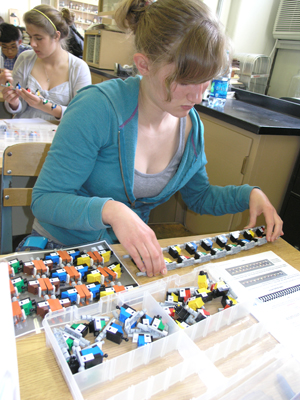Uni Seniors Take an Initial Look at the LEGO® DNA Learning Center Set

Science teacher David Stone discusses procedures for using the Lego kits with students during the evaluation session.
June 22, 2012
"LEGOs? Cool!!" This was the reaction of one student at the University of Illinois Laboratory High School (Uni High). The LEGO DNA Learning Center Set had arrived. The class’s curiosity was definitely piqued, wondering what the double helix might look like in LEGO pieces.
The materials in question were not the usual LEGO toys, but molecular designs developed and field-tested by Dr. Kathleen Vandiver, an award winning Massachusetts science teacher and outreach director at the Massachusetts Institute of Technology (MIT) Center for Environmental Health Sciences. These LEGO sets included DNA for building genes, amino acids for creating proteins, and mRNA and tRNA molecules for stepping through the processes of protein synthesis.

In order to evaluate the written instructions as well as the activities, partners took turns reading and doing the activities.
Through collaboration with the I-STEM Education Initiative at the University of Illinois at Urbana-Champaign, Uni High received one of the 21 prototype sets being placed across the country for evaluation. Other schools include the Green Dot Charter Schools in Los Angeles, the Boston Public Schools, and several rural high schools in Maine.
Since there wasn't time left in the school year for working with the ninth grade class, which is the intended age group, Mr. Stone asked the seniors in his Human Genetics and Society class to break out the sets and to share their first impressions. For two class periods, students worked in pairs following the steps in the basic instruction booklets for DNA and protein activities. Advanced-level materials—which would be more appropriate for this class—are still under development and will arrive next year.

Two students lay out the pieces on the enclosed illustrated sheets prior to beginning construction of their DNA strand.
Dr. Vandiver says that one of the reasons she chose to work with LEGO was because they were made to be manipulated. "LEGO components are well suited for demonstrating the actions that molecules perform as well as what they look like, in major contrast to most models which portray molecules as static entities."
Stone conducted an informal assessment survey of the class after they had used the LEGO kits, and the results were generally positive, but with a few suggestions for improvements. Among the strengths noted was the ability to easily visualize the molecules, which is not always easy to do with more traditional learning materials. It was also a fun way to learn. Many students agreed that they would be a useful learning aid, especially for introductory biology students.

Two students discuss the next step as they try out the kit.
"The primary weakness was that the LEGOs weren't versatile enough to show the importance and beauty of the action of enzymes involved in DNA replication," Stone commented, "so readily seen in various animations on websites and YouTube videos."
However, recognizing that multiple instructional strategies are of great benefit, he plans to use the LEGOs in his biology classes next year: "I think the LEGOs can be quite helpful in instruction and look forward to using them in December with my Introductory Biology class. The strengths are the clarity of the instructions and the opportunity to construct and manipulate the student-produced molecule models."
Additionally, University of Illinois Professor and I-STEM Director, Dr. Lizanne De Stefano, will be involved in design of the formal evaluation instruments and protocol for this project.
Acknowledgements: This LEGO DNA Learning Center Set was provided by MIT through a grant from the Arthur Vining Davis Foundations (http://www.avdf.org ). The University of Illinois, MIT and Georgia Tech are partners in the Emergent Behaviors of Integrated Cellular Systems (EBICS) Center (www.ebics.net), which is an NSF funded Science and Technology Center.

Student prepares the DNA to demon-strate semi-conservative replication.
Of interest: Dr. Vandiver is also developing a curriculum for nursing students. This LEGO Genetics Toolkit for Nurses is designed for teaching pharmacogenetics and gene-environment interactions. With personalized medicine on the horizon, many health professionals could benefit from a LEGO experience with DNA as corroborated by Uni students' statements.
This link is to the site that has the materials posted for the LEGO DNA Learning Center Set, including (teacher guide, student booklets, PPT, movies, etc.): http://mindandhand.mit.edu/educators/curriculum-packages/lego-dna.shtml
More: 8-12 Outreach, I-STEM Initiatives, Uni High













.jpg)
















